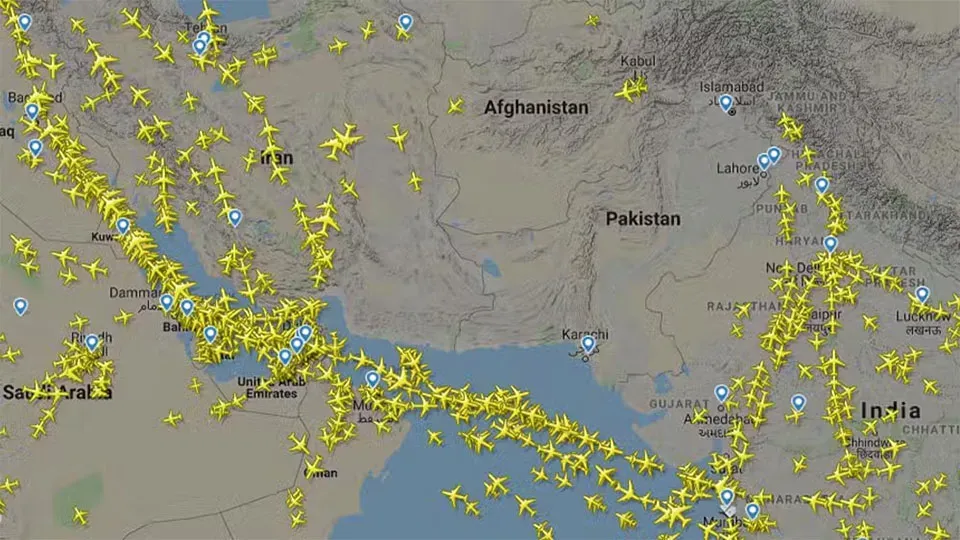The closure of Pakistan’s airspace to Indian airlines marks a significant shift in international travel dynamics, particularly affecting routes to Europe, North America, and the Middle East. Airlines such as Air India and IndiGo must now navigate longer flight paths, which not only increases fuel costs but may also necessitate additional refueling stops. This disruption could lead to potential flight cancellations and a challenge in maintaining competitive airfares. Interestingly, despite these operational hurdles, analysts anticipate that the overall airfare increase for passengers might remain minimal. As the aviation sector adapts to these changes, the impact on international travel patterns and Middle East flights will be closely monitored.
The recent decision by Pakistan to restrict air traffic for Indian airlines has sparked considerable attention among travelers and carriers alike. With this airspace closure, major airlines are compelled to find alternative routes, leading to longer travel times and possible adjustments in scheduling. This situation affects a range of flights destined for international hubs, pushing airlines to manage the increased operational costs associated with flight rerouting. Moreover, it raises concerns about potential airfare hikes that could affect countless travelers planning their journeys. As these developments unfold, the implications for air travel, particularly concerning routes to the Middle East and Europe, will be crucial for both holidaymakers and business travelers.
The Consequences of Pakistan Airspace Closure on Indian Airlines
The recent closure of Pakistan’s airspace to Indian airlines has instigated a wave of changes for carriers that rely on this critical travel corridor. Airlines like Air India and IndiGo have had to make significant adjustments to their flight operations, rerouting many international flights that once smoothly traversed the skies over Pakistan. This situation not only complicates flight logistics but also introduces the potential for increased operational costs due to longer flight times and the need for additional refueling stops along the route.
With the airspace closure impacting around 50 routes, flights connecting India to major destinations in Europe and the Middle East are experiencing disruptions. The longer distances are expected to elevate fuel consumption, compelling airlines to reevaluate their flight schedules and ticket pricing strategies. Passengers may face delays and alterations in travel plans, creating a ripple effect throughout the industry as airlines grapple with the fallout of the closure.
Flight Rerouting and its Financial Implications
The rerouting of flights due to the closure of Pakistani airspace raises important questions regarding airfare stability for affected travelers. While logistical challenges are evident, analysts suggest that the operational costs incurred from these reroutings may not result in a corresponding rise in ticket prices. Historical data suggests that during prior airspace closures, like the one faced by Indian airlines in 2019, the substantial financial hit—estimated at around $82 million—did little to affect ticket pricing overall.
Despite the inconvenience posed by longer flight routes and the need for additional stops, it appears that carriers may absorb some of these costs to maintain competitiveness in a challenging market. As Indian airlines strive to ensure that international travel remains affordable, passengers can take solace in the expectation that fare increases will likely be minimal, particularly for popular routes.
Shifts in International Travel Dynamics Amidst Airspace Restrictions
The closure of Pakistan’s airspace is anticipated to significantly shift the dynamics of international travel for Indian carriers, particularly concerning flights to key destinations in the Middle East. As approximately 49.3% of outbound travel in 2023 is directed towards this region, the current airspace situation presents serious ramifications for both carriers and passengers. Rerouting may lead to longer travel times, causing potential frustration among travelers who look for the most efficient flights.
Moreover, this shift in travel patterns may influence not only ticket costs but also the overall competition among airlines. As some Indian carriers are forced to deviate from traditional routes, those airlines maintaining overflight rights could seize the opportunity to capture the increased passenger demand. This evolving landscape highlights the essential need for strategic adjustments by Indian airlines to navigate both operational challenges and market opportunities.
Impact on Middle East Flights and Demand
Middle East flights from India are among the most popular international travel routes, often facilitated via Pakistani airspace. The current closure could lead to significant changes in how travelers design their itineraries, particularly for those heading to destinations like Dubai and Riyadh. Airlines are actively exploring alternatives to preserve their market share while ensuring that they continue to offer competitive services.
Additionally, the potential for increased flight durations and rerouting might dissuade some travelers or push them towards alternative carriers that still retain access to these critical airways. As travelers adjust to the new reality of international flight operations, carriers must also innovate by providing better services, enhancing layover experiences, and offering attractive fare options to retain customer loyalty.
Analysis of Airfare Trends in Response to Operational Changes
An essential aspect of the ongoing airspace closure is its potential effect on airfare trends. While the rerouting of flights typically suggests an increase in operational expenses, experts in the aviation industry argue that fares may not rise significantly. Historical patterns from previous airspace bans show that airlines have often absorbed increased costs instead of passing them on to passengers, which may be the case now as well.
For instance, despite airline operational upheaval, specific routes have recently experienced fare reductions, potentially due to competitive pressures amongst Indian carriers. Such dynamics illustrate how airlines are working diligently to maintain affordability in their fare structures, which can be reassuring for travelers who may be apprehensive about costs in light of these changes.
Understanding the Operational Challenges Faced by Airlines
The operational challenges resulting from Pakistan’s airspace closure are multifaceted, impacting everything from flight planning to customer service responses. Airlines like IndiGo and Air India will need to urgently adapt their operational frameworks to account for changes in air routing, which can lead to inefficient schedules and increased turnaround times. The need for real-time assessments and strategic route planning has never been more vital in this context.
Furthermore, airlines are likely to experience increased pressure to maintain high levels of customer service during these disruptions. Transparent communication regarding flight status, potential delays, and changes in schedules will be crucial to keeping passengers informed. The ability to adapt quickly to operational setbacks will be a determining factor for airlines as they compete in a financially sensitive market.
Future Outlook of Indian Airlines Amidst Geopolitical Tensions
The ongoing geopolitical tensions between India and Pakistan underscore the fragile nature of airspace access and its implications for Indian airlines. As the situation continues to evolve, airlines must remain agile in their operations and ready to respond to any further restrictions or changes in airspace access. This reality complicates strategic planning, but it also provides a unique opportunity for airlines to innovate in how they serve their passengers.
Indian airlines will likely focus on enhancing their service offerings to adapt to these challenging situations, hoping to retain customer loyalty amidst operational disruptions. This might include introducing flexible booking policies, improved in-flight services, and better options for international travel to mitigate the impact of rerouting.
Passenger Perspectives on Travel Adjustments Amid Changes
From a passenger’s perspective, the airspace closure will necessitate higher levels of planning for international travel. With the need to accommodate longer flight durations and potential layovers, travelers will need to consider how these changes affect their overall travel experiences. This might include budgeting extra time for transfers and anticipating delays that stem from the airspace rerouting.
Moreover, travelers may begin to explore alternative routes or carriers that continue to benefit from less restricted overflight permissions. Increased awareness of flight options could lead to changes in consumer behavior, as travelers weigh the balance between cost and convenience when choosing their flights.
Exploring the Role of Regulatory Changes in Air Travel
The regulatory landscape surrounding air travel is continually evolving, particularly as geopolitical relationships shift. The closure of airspace can prompt airlines and governments to reconsider existing agreements and air travel regulations. Cooperation between countries often becomes crucial in ensuring that air travel remains accessible and efficient, despite political tensions.
With the airspace situation between India and Pakistan in flux, stakeholders must engage in dialogues to facilitate better communication and potential agreements that can enhance air travel operations. Future discussions may aim to establish more favorable conditions for airlines and ultimately the passengers that rely on them.
Frequently Asked Questions
How does the Pakistan airspace closure impact Indian airlines?
The Pakistan airspace closure directly affects Indian airlines by forcing them to reroute their flights to Europe, North America, Central Asia, and the Middle East. This leads to increased flight times and, in some cases, the necessity for fuel stops or even flight cancellations.
Will the closure of Pakistan airspace lead to an increase in airfare for international travel?
Despite the rerouting caused by the Pakistan airspace closure, analysts suggest that airfare for international travel may not see significant increases. Historical data indicates that operational challenges do not always translate to higher ticket prices.
Which routes are affected by the Pakistan airspace closure for Indian airlines?
The Pakistan airspace closure affects major routes operated by Indian airlines, including flights to destinations such as Almaty and Tashkent. Airlines like Air India and IndiGo are recalculating their paths to North America and Europe, leading to potential delays.
What measures are Indian airlines taking in response to the Pakistan airspace closure?
In response to the Pakistan airspace closure, Indian airlines are rerouting their flights, issuing refunds for cancelled routes, and rescheduling options for affected passengers. These adjustments aim to minimize the impact on travelers while ensuring safety and compliance.
Can travelers expect significant delays due to the airspace closure over Pakistan?
Yes, travelers can expect significant delays due to the airspace closure over Pakistan, as flights now require longer routes and may include additional refueling stops. For instance, direct flights that previously operated non-stop may now have to make layovers, like the New Delhi to New York route which has added stops.
How is the Pakistan airspace closure affecting flights to the Middle East?
The Pakistan airspace closure is particularly impactful for flights to the Middle East, as many routes from India typically transit through Pakistan. As a result, there may be a shift in travel dynamics, potentially influencing travel patterns toward alternative routing.
What historical context enables understanding of the Pakistan airspace closure’s impact on air travel?
Understanding the historical context of previous airspace bans, like the five-month closure in 2019 and the one imposed by Russia, provides insight into how operational costs may rise without a corresponding increase in airfare, reflecting the complex relationship between routing, costs, and passenger pricing.
What percentage of outbound travel from India was directed towards the Middle East in 2023, and how does it relate to the airspace closure?
In 2023, approximately 49.3% of outbound travel from India was directed towards the Middle East. The Pakistan airspace closure complicates this travel by necessitating longer routes, thus highlighting its significance in Indian air travel dynamics.
| Key Point | Details |
|---|---|
| Closure of Airspace | Pakistan has closed its airspace to Indian airlines, forcing them to change routes. |
| Affected Routes | Indian airlines, including Air India and IndiGo, must navigate longer routes to Europe, North America, Central Asia, and the Middle East. |
| Operational Costs vs Airfares | While operational costs may increase due to longer distances and needed refueling stops, airfares are not expected to rise significantly. |
| Major Airlines Impacted | IndiGo estimates up to 50 affected routes; some direct flights to Almaty and Tashkent have been suspended. |
| Historical Context | Previous airspace bans, such as one by Russia, have shown that increased costs do not necessarily result in higher fares for passengers. |
| Competitiveness | The closure may hinder Indian carriers’ competitiveness against airlines that still have overflight access. |
Summary
The recent Pakistan airspace closure significantly impacts Indian airlines by forcing them to modify flight routes, increasing operational costs due to longer distances and necessary refueling stops. However, surprisingly, experts predict that ticket prices may not rise as a direct result of these disruptions. With a substantial portion of Indian outbound travel directed towards the Middle East, the management of routes and operational efficiency will become crucial for Indian carriers as they navigate these new challenges in the region’s aviation landscape.



